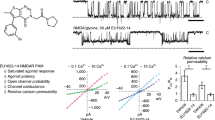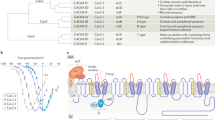Abstract
The influx of Na+ is fundamental to electrical signalling in the nervous system and is essential for such basic signals as action potentials and excitatory postsynaptic potentials1. During periods of bursting or high levels of discharge activity, large increases in intracellular Na+ concentration ([Na+]i) are produced in neuronal soma and dendrites2,3,4. However, the intracellular signalling function of raised postsynaptic [Na+]i is unknown. Here we show that [Na+]i regulates the function of NMDA (N-methyl-D-aspartate) receptors, a principal subtype of glutamate receptor5. NMDA-receptor-mediated whole-cell currents and NMDA-receptor single-channel activity were increased by raising [Na+]i and channel activity decreased upon lowering [Na+]i; therefore, the activity of NMDA channels tracks changes in [Na+]i. We found that the sensitivity of the channel to Na+ was set by a Src kinase that is associated with the channel. Raising [Na+]i selectively increased synaptic responses mediated by NMDA receptors, but not by non-NMDA receptors. Thus, the change in postsynaptic [Na+]i that occurs during neuronal activity is a signal for controlling the gain of excitatory synaptic transmission. This mechanism may be important for NMDA-receptor-dependent plasticity and toxicity in the central nervous system.
This is a preview of subscription content, access via your institution
Access options
Subscribe to this journal
Receive 51 print issues and online access
$199.00 per year
only $3.90 per issue
Buy this article
- Purchase on Springer Link
- Instant access to full article PDF
Prices may be subject to local taxes which are calculated during checkout





Similar content being viewed by others
References
Hille, B. Ionic Channels of Excitable Membranes (Sinauer, Sunderland, (1992)).
Jaffe, D. B. et al. The spread of Na+ spikes determines the pattern of dendritic Ca2+ entry into hippocampal neurons. Nature 357, 244–246 (1992).
Rose, C. R. & Ransom, B. R. Regulation of intracellular sodium in cultured rat hippocampal neurons. J. Physiol. (Lond.) 499, 573–587 (1997).
Callaway, J. C. & Ross, W. N. Spatial distribution of synaptically activated sodium concentration changes in cerebellar Purkinje neurons. J. Neurophysiol. 77, 145–152 (1997).
McBain, C. J. & Mayer, M. L. N-methyl-D-aspartic acid receptor structure and function. Physiol. Rev. 74, 723–760 (1994).
Sandeaux, R., Sandeaux, J., Gavach, C. & Brun, B. Transport of Na+ by monensin across bimolecular lipid membranes. Biochim. Biophys. Acta 684, 127–132 (1982).
Harootunian, A. T., Kao, J. P., Eckert, B. K. & Tsien, R. Y. Fluorescence ratio imaging of cytosolic free Na+ in individual fibroblasts and lymphocytes. J. Biol. Chem. 264, 19458–19467 (1989).
Wong, E. H. & Kemp, J. A. Sites for antagonism on the N-methyl-D-aspartate receptor channel complex. Annu. Rev. Pharmacol. Toxicol. 31, 401–425 (1991).
Nowak, L. M. & Wright, J. M. Slow voltage-dependent changes in channel open-state probability underlie hysteresis of NMDA responses in Mg(2+)-free solutions. Neuron 8, 181–187 (1992).
Strichartz, G., Rando, T. & Wang, G. K. An integrated view of the molecular toxinology of sodium channel gating in excitable cells. Annu. Rev. Neurosci. 10, 237–267 (1987).
Edmonds, B. & Colquhoun, D. Mechanisms of activation of glutamate receptors and the time course of excitatory synaptic currents. Annu. Rev. Physiol. 57, 495–519 (1995).
Yu, X. M., Askalan, R., Keil, G. J. I. & Salter, M. W. NMDA channel regulation by channel-associated protein tyrosine kinase Src. Science 275, 674–678 (1997).
Liu, X. et al. Regulation of c-Src tyrosine kinase activity by the Src SH2 domain. Oncogene 8, 1119–1126 (1993).
Legendre, P., Rosenmund, C. & Westbrook, G. L. Inactivation of NMDA channels in cultured hippocampal neurons by intracellular calcium. J. Neurosci. 13, 674–684 (1993).
Rosenmund, C. & Westbrook, G. L. Calcium-induced actin depolymerization reduces NMDA channel activity. Neuron 10, 805–814 (1993).
Medina, I., Filippova, N., Bakhramov, A. & Bregestovski, P. Calcium-induced inactivation of NMDA receptor-channels evolves independently of run-down in cultured rat brain neurons. J. Physiol. (Lond.) 495, 411–427 (1996).
Lu, Y. M., Roder, J. C., Davidow, J. & Salter, M. W. Src activation in the induction of long-term potentiation in CA1 hippocampal neurons. Science 279, 1363–1368 (1998).
Crill, W. E. Persistent sodium current in mammalian central neurons. Annu. Rev. Physiol. 58, 349–362 (1996).
Parri, H. R. & Crunelli, V. Sodium current in rat and cat thalamocortical neurons: role of a non-inactivating component in tonic and burst firing. J. Neurosci. 18, 854–867 (1998).
Pape, H. C. Queer current and pacemaker: the hyperpolarization-activated cation current in neurons. Annu. Rev. Physiol. 58, 299–327 (1996).
Congar, P., Leinekugel, X., Ben-Ari, Y. & Crepel, V. Along-lasting calcium-activated nonselective cationic current is generated by synaptic stimualtion or exogenous activation of group I metabotropic glutamate receptors in CA1 pyramidal neurons. J. Neurosci. 17, 5366–5379 (1997).
Xiong, Z., Lu, W. & MacDonald, J. F. Extracellular calcium sensed by a novel cation channel in hippocampal neurons. Proc. Natl Acad. Sci. USA 94, 7012–7017 (1997).
Chidekel, A. S., Friedman, J. E. & Haddad, G. G. Anoxia-induced neuronal injury: role of Na+ entry and Na+-dependent transport. Exp. Neurol. 146, 403–413 (1997).
Salter, M. W. & Hicks, J. L. ATP-evoked increases in intracellular calcium in cultured neurones and glia from the dorsal spinal cord. J. Neurosci. 14, 1563–1575 (1994).
Wang, Y. T. & Salter, M. W. Regulation of NMDA receptors by tyrosine kinases and phosphatases. Nature 369, 233–235 (1994).
Mayer, M. L. & Westbrook, G. L. The physiology of excitatory amino acids in the vertebrate central nervous system. Prog. Neurobiol. 28, 197–276 (1987).
Wang, L.-Y., Salter, M. W. & MacDonald, J. F. Regulation of kainate receptors by cAMP-dependent protein kinase and phosphates. Science 253, 1132–1135 (1991).
Paoletti, P. & Ascher, P. Mechanosensitivity of NMDA receptors in cultured mouse central neurons. Neuron 13, 645–655 (1994).
Wang, Y. T., Yu, X. M. & Salter, M. W. Ca(2+)-independent reduction of N-methyl-D-aspartate channel activity by protein tyrosine phosphatase. Proc. Natl. Acad. Sci. USA 93, 1721–1725 (1996).
Bekkers, J. M. & Stevens, C. F. NMDA and non-NMDA receptors are co-localized at individual excitatory synapses in cultured rat hippocampus. Nature 341, 230–233 (1989).
Acknowledgements
We thank J. F. MacDonald, Y. T. Wang, L. Y. Wang and Y. De Koninck for comments on the manuscript; Y. De Koninck for software used in analysis; and J. L. Hicks for preparing and maintaining cell cultures and for technical assistance. This work was supported by a grant from the Medical Research Council of Canada to M.W.S. and by the Nicole Fealdman Memorial Fund. M.W.S. is an MRC Scientist and X.-M.Y is an MRC Scholar.
Author information
Authors and Affiliations
Corresponding author
Supplementary Information
Rights and permissions
About this article
Cite this article
Yu, XM., Salter, M. Gain control of NMDA-receptor currents by intracellular sodium. Nature 396, 469–474 (1998). https://doi.org/10.1038/24877
Received:
Accepted:
Issue Date:
DOI: https://doi.org/10.1038/24877
This article is cited by
-
Deficits in integrative NMDA receptors caused by Grin1 disruption can be rescued in adulthood
Neuropsychopharmacology (2023)
-
NMDA receptor inhibition prevents intracellular sodium elevations in human olfactory neuroepithelial precursors derived from bipolar patients
Scientific Reports (2022)
-
Tripartite signalling by NMDA receptors
Molecular Brain (2020)
-
Activation of sodium channels by α-scorpion toxin, BmK NT1, produced neurotoxicity in cerebellar granule cells: an association with intracellular Ca2+ overloading
Archives of Toxicology (2017)
-
Maternal Care Differentially Affects Neuronal Excitability and Synaptic Plasticity in the Dorsal and Ventral Hippocampus
Neuropsychopharmacology (2015)
Comments
By submitting a comment you agree to abide by our Terms and Community Guidelines. If you find something abusive or that does not comply with our terms or guidelines please flag it as inappropriate.



